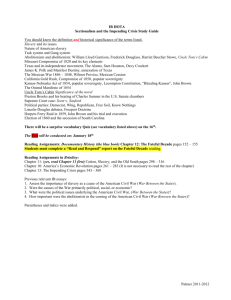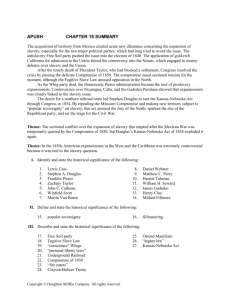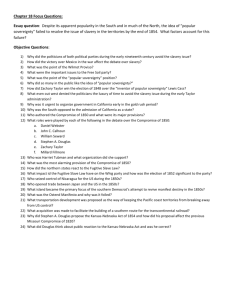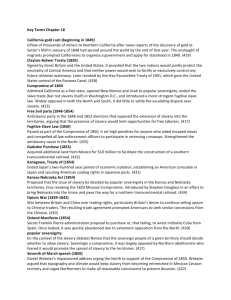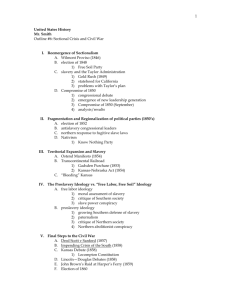APUS Unit 5 Ch.18 Sectional Struggle PPT
advertisement
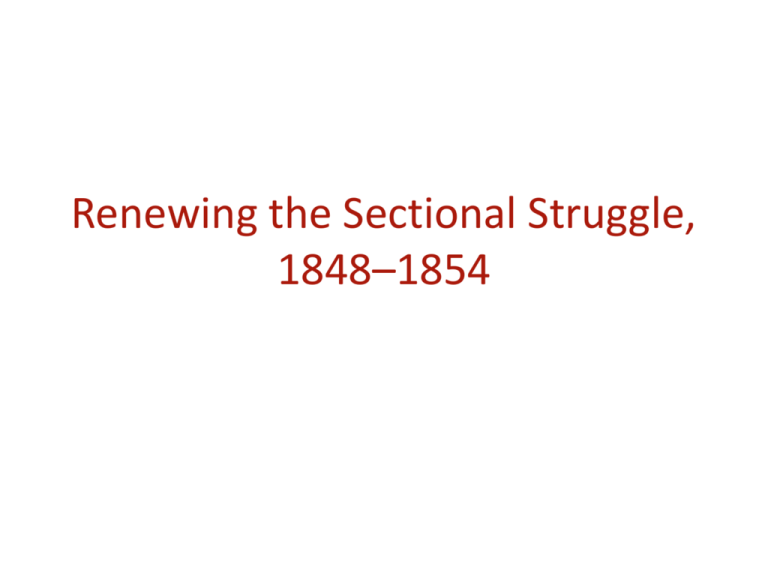
Renewing the Sectional Struggle, 1848–1854 • Key Concept 5.1: The United States became more connected with the world, pursued an expansionist foreign policy in the Western Hemisphere, and emerged as the destination for many migrants from other countries. • Key Concept 5.2: Intensified by expansion and deepening regional divisions, debates over slavery and other economic, cultural, and political issues led the nation into civil war. • Key Concept 5.3: The Union victory in the Civil War and the contested reconstruction of the South settled the issues of slavery and secession, but left unresolved many questions about the power of the federal government and citizenship rights. Election of 1848 • Zachary Taylor- Whig – War hero – Won 163-127 • Lewis Cass- Democrat • Martin Van Buren- Free Soil Party • http://www.270towin.com/1848_Election/ Popular Sovereignty • Democrats in 1848: – Polk pledged himself to a single term – National Convention turned to aging leader General Lewis Cass – Platform silent on issue of slavery – Cass's views were well known because he was reputed father of popular sovereignty • Popular sovereignty— • doctrine stated the sovereign people of a territory, under general principle of the Constitution, should themselves determine status of slavery – Had persuasive appeal: • Public liked it because it accorded with democratic tradition of self-determination • Politicians liked it because it seemed a comfortable compromise between: – Free-soilers' bid to ban slavery in territories – Southern demands that Congress protect slavery in territories • Popular sovereignty tossed slavery problem to people in various territories • Advocates hoped to dissolve slavery from a national issue to a series of local issues • Yet, popular sovereignty had one fatal defect: – Might spread blight of slavery • Free-Soilers' party platform: • Condemned slavery not so much for enslaving blacks but for destroying chances of free whites to rise up from wage-earning dependence to self-employment • Argued that only with free soil in West could American commitment to upward mobility continue to flourish • First party organized around issue of slavery and confined to single section • Foreshadowed emergence of Republicans p379 Map 18-1 p380 The California Rush • Discovery of gold near Sutter's Mill, California, early in 1848 • Forty-Niners • Tremendous influx of people • Drafted a constitution that excluded slavery and appealed for admission as a state p381 • South in 1850 was relatively well-off: – National leadership: Taylor in White House – Had a majority in cabinet and on Supreme Court – Cotton fields expanding – Cotton prices profitably high – Few believed slavery seriously threatened in fifteen states • South deeply worried by ever-tipping political balance: 15 slave states & 15 free states • Admission of California would destroy balance in Senate • Potential slave territory was running short • Already agitation in territories of New Mexico & Utah for admission as non-slave states • California might establish a precedent Southern “grievances” – Angered by agitation in North for abolition of slavery in District of Columbia – Upset over loss of runaway slaves: • Assisted by Underground Railroad • Harriet Tubman The Underground Railroad p382 Map 18-2 p382 The Compromise of 1850 • Clay, Calhoun and Webster returned to the Senate • Spirit Calhoun and Webster documents (pp.292-296) • Webster's famed Seventh of March speech (1850) was his finest: – Visibly strengthened Union sentiment – Pleased banking and commercial centers of North—stood to lose millions by secession – Free-Soilers and abolitionists called him a traitor, – Reproaches most unfair; Webster regarded slavery as evil, but disunion as worse Breaking the Congressional Logjam • Heat in Congress: – “Union savers”—Clay, Webster, Douglas—orated across North on behalf of compromise – Southern “fire-eaters” opposed concession – June 1850, southern extremists met in Nashville: • Took strong position in favor of slavery • Condemned compromise measure Table 18-1 p384 p385 Map 18-3 p386 p387 Map 18-4 p388 Defeat and Doom for the Whigs • • • • Election of 1852 Franklin Pierce- Democrat Winfield Scott- Whig Whigs split over issue of slavery and Pierce won • Marked end of Whig party • Whigs' complete death: – Augured eclipse of national parties and rise of purely sectional political alignments – Won two presidential elections (1840, 1848) with war heroes • Greatest contribution was to help uphold ideal of Union through: – Electoral strength in South – Eloquence of leaders Clay & Webster Expansionist Stirrings South of the Border – Clayton-Bulwer Treaty (1850) stipulated neither U.S.A. nor Britain would fortify or seek executive control over any future isthmian waterway • (later rescinded by Hay-Pauncefote Treaty of 1910) – Ostend Manifesto—urged administration to offer $120 million for Cuba • Secret manifesto leaked out • Northern free-soilers enraged Map 18-5 p389 The Allure of Asia • Americans wanted access to the rich markets of Asia – Opium War—fought by Britain for right to peddle opium in China: • Britain gained free access to five so-called treaty ports • Control of island of Hong Kong • President Tyler wanted to secure comparable concession for United States • Treaty of Wanghia: first formal diplomatic agreement between U.S. and China on July 3, 1844: – secured vital commercial rights and privileges from Chinese – “Most favorable rights” granted to U.S.A. – “Extraterritoriality”—provided Americans, accused of crimes in China, a trial before American officials, not in Chinese courts – American trade with China increased – Treaty also encouraged arrival of American missionaries; thousands came – Success in China prompted U.S. goals for Japan: • Japan had earlier withdrawn into cocoon of isolationism for over 200 years • Tokugawa Shogunate protected Japan's insularity • By 1853, Japan ready to emerge from self-imposed quarantine Commodore Perry and Japan – President Fillmore dispatched Commodore Matthew Perry in 1852 for Japan – His four “black ships” steamed into Edo (later Tokyo Bay) on July 8, 1853 – Perry requested free trade & friendly relations, then left promising to return next year to receive Japan's reply – Perry returned in February 1854; persuaded Japan to sign Treaty of Kanagawa on March 31, 1854 p391 – Perry “opened” Japan after its two-centuries of isolation – Less than a decade later, “Meiji Restoration” would: • End Shogunate • Propel Japan headlong into modern world • Eventually into military crash with United States Pacific Railroad Promoters and the Gadsden Purchase Map 18-6 p392 Douglas’s Kansas-Nebraska Scheme • 1854 • The Nebraska Territory would be divided into the territories of Kansas and Nebraska. • The status of slavery would be determined by popular sovereignty. • It would require the repeal of the Missouri Compromise • (Douglas had financial stakes in Chicago real estate and railway stock and wanted to gain Southern support for Chicago as terminus of new railroad) p393 • “And what does slavery ask now? Why, sir, it demands that a time-honored and sacred compact (Missouri Compromise) shall be rescinded- a compact which has endured through a whole generation. . . .” • “The old questions between political parties are at rest. No great question so thoroughly possesses the public mind as this of slavery.” – Salmon Chase, 1854 Map 18-7 p393 The Kansas-Nebraska Act Consequences • Anti-slavery Northerners saw it as an act of bad faith. All future compromise with the South would be more difficult. • The Fugitive Slave Law of 1850 would no longer be enforced • Its passage shattered the Democratic party The Republican Party • -It began in the Middle West as a moral protest against slavery. It included a range of disgruntled elements (former Whigs, Free-Soilers, Democrats, Know-Nothings, and others opposed to the Kansas-Nebraska Act). • by 1856 it had elected a Speaker of the House • it was a second major party almost over night. • it was a purely sectional party that did not exist below the Mason-Dixon line. p395
